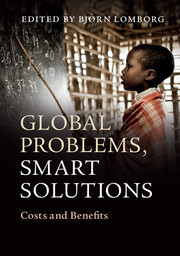Book contents
- Frontmatter
- Contents
- List of Figures
- List of Tables
- List of Contributors
- Acknowledgments
- Selected abbreviations and acronyms
- Introduction
- Part I The Solutions
- 1 Armed Conflicts
- 2 Ecosystems and Biodiversity
- 3 Chronic Disease
- 4 Climate Change
- 5 Education
- 6 Hunger and Malnutrition
- 7 Infectious Disease, Injury, and Reproductive Health
- 8 Natural Disasters
- 9 Population growth
- 10 Water and Sanitation
- 11 Corruption and Policy Reform
- 12 Trade Barriers and Subsidies
- Part II Ranking the Opportunities
- Conclusion: Making Your Own Prioritization
- Index
- References
11 - Corruption and Policy Reform
Published online by Cambridge University Press: 05 June 2014
- Frontmatter
- Contents
- List of Figures
- List of Tables
- List of Contributors
- Acknowledgments
- Selected abbreviations and acronyms
- Introduction
- Part I The Solutions
- 1 Armed Conflicts
- 2 Ecosystems and Biodiversity
- 3 Chronic Disease
- 4 Climate Change
- 5 Education
- 6 Hunger and Malnutrition
- 7 Infectious Disease, Injury, and Reproductive Health
- 8 Natural Disasters
- 9 Population growth
- 10 Water and Sanitation
- 11 Corruption and Policy Reform
- 12 Trade Barriers and Subsidies
- Part II Ranking the Opportunities
- Conclusion: Making Your Own Prioritization
- Index
- References
Summary
Policies designed to improve the quality of life for the poor and to spur economic growth often fail. A program that succeeds in one country or even in one village may not work in another. Promising experiments may not be capable of replication and may be impossible to scale up to cover an entire country. Reformers are told: “One size does not fit all.” Yet, problems of poor health, low educational attainment, degraded natural environments, and violence and crime are widespread. Why shouldn't similar policies work in various settings? We argue that, over and above substantive differences, a key reason for cross-country differences in policy efficacy is the quality of government and the ubiquity of corruption and related forms of self-dealing by politicians, civil servants, and the private individuals and business interests with whom they interact. A policy that works quite well in one country may fail or be coopted in another with lower-quality governance.
Understanding the incentives for corruption and self-dealing is a precondition for making progress on the other challenges facing the world. A beautifully designed policy that seems to have high net benefits may fail in the face of weak institutions. One response is to urge a crackdown by law-enforcement authorities, but that strategy will seldom be sufficient. Those seeking to further economic development need to understand the institutional origins of corruption and take them into account in designing policies. Certain policies may simply be infeasible because they are riddled with incentives for illicit self-dealing. Others may need to be combined with programs explicitly designed to reduce the incentives for corruption built into existing institutions.
- Type
- Chapter
- Information
- Global Problems, Smart SolutionsCosts and Benefits, pp. 632 - 672Publisher: Cambridge University PressPrint publication year: 2013
References
- 5
- Cited by



